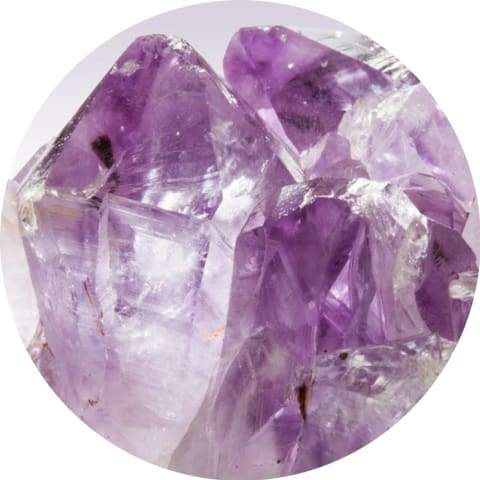Amethyst
Properties of amethyst
Amethyst was a rather rare stone in antiquity. Its name is believed to derive from ancient Greek and is composed of the prefix *a* and the verb *methuô*, meaning "to be drunk." This precious stone owes its name to its purple and violet color, reminiscent of wine dipped in water. Consequently, amethyst acquired a reputation for protection against drunkenness.
Amethyst belongs to the quartz family, its crystal system is trigonal, and its transparency ranges from clear to translucent. Its purple color is due to the presence of iron, and its hardness is 7 on the Mohs scale.
Today, amethyst has become a fairly common gemstone thanks to the abundant deposits discovered all over the world, including France, Belgium, Canada, Madagascar, Brazil, Uruguay...
History of the amethyst
Ancient civilizations highly valued amethyst. From the Egyptians to the Romans, the Greeks, and the Hebrews, to name just a few, great civilizations revered amethyst. This stone has featured in various ancient myths and legends that attribute extraordinary powers to a stone created or even colored by the gods.
Present in the jewelry and pendants of the pharaohs, amethyst seems to have fascinated the ancient Greeks to the point of being the subject of a famous myth about the genesis of this stone. Legend tells that Dionysus, the Greek god of wine, swore revenge on the first human being unfortunate enough to meet him, a young woman named Amethyst who had to suffer the god's wrath.
Discover our Amethyst Support Stone

Begging Artemis to save her from her cruel fate, the goddess answered the girl's pleas by transforming her into a statue of white quartz. Once his fury subsided, Dionysus regretted his cruel decision and, repentant, poured wine over the crystal, which had since taken on a purple hue.
The Greeks and Romans believed in the virtues of amethyst against drunkenness, which would explain why they placed this stone in their drinking cups. The Hebrews considered amethyst the symbol of the tribe of Ahlamah and included it among the stones of the gates of Jerusalem.
In the Middle Ages, the amethyst was adopted by the Catholic Church as a symbol of chastity and renunciation of earthly temptations. The amethyst also held a special appeal for European monarchs. The scepter of the Queen of England, for example, is set with an amethyst globe.

Benefits of Amethyst
Amethyst has undeniable benefits for both physical and mental health. Its healing properties are quite numerous. Highly beneficial for skin problems, it helps treat acne and other skin blemishes or lesions. Amethyst also has calming properties that can alleviate migraine pain and other nervous system disorders.
Amethyst is also a regulating stone, helping to restore calm breathing and smoother, more balanced blood circulation. Problems with stress, anxiety, nervous and muscular tension, and depressive states tend to resolve quickly when an amethyst stone is kept close. Amethyst is also said to promote sleep and ensure dreams purified of the negative vibrations responsible for nightmares and other sleep disorders.
Discover our amethyst blossom bracelet

On a spiritual level, amethyst is considered the stone of wisdom and constitutes a powerful link to the divine. These properties purify the atmosphere around the wearer through the powerful energy field that amethyst generates.
Those who practice meditation will find in this stone an ally for opening the spirit, expanding the field of perception, and promoting spiritual elevation. Amethyst helps one become more receptive to vibrations and messages both within and without.
Amethyst is associated with the seventh chakra or crown chakra located at the top of the skull; this chakra is at the origin of spiritual openness and empathetic and altruistic connection with others.
The stone is associated with the signs of Virgo, Sagittarius, Aquarius, and Pisces. Its planets are Neptune and Jupiter, and its element is water.
The purification and recharging of the amethyst is done by immersing the stone for a few hours in demineralized and slightly salty water, away from light.


















